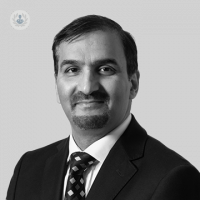Getting rid of varicose veins
Escrito por:Varicose veins – many of us have them, and a lot us don’t like them, but can we prevent varicose veins? If we already have them, can we treat them? Leading vascular surgeon, Mr S. Tawqeer Rashid, discusses the options of both varicose vein prevention and treatment.

Can you prevent varicose veins?
Regrettably, you cannot really prevent varicose or spider veins, which often run in some families. Women are more likely to seek treatment for varicose veins and up to 50% of women may be affected at some point during their life. There is no strong evidence that they are more common in women and it may be that women are just more aware of the problem.
Does pregnancy cause varicose veins?
Many women report getting varicose veins after they fall pregnant. Historically, this was felt due to changed hormone levels, the extra blood in the body causing veins to get bigger and the enlarged womb with the baby pressing on nearby veins and so increasing the pressure in turn on the veins in the legs. Sometimes after the baby is born the varicose veins may disappear though with successive pregnancies, abnormal veins are more likely to remain, however. More recently it is felt the link between pregnancy and varicose veins may, in fact, be coincidental and not linked as previously thought.
What does surgery for varicose veins involve?
There are a whole host of treatments for varicose veins, from traditional open surgery, a variety of keyhole or endovenous ablation techniques and injections using sclerotherapy.
1. Endovenous ablation:
This is a form of keyhole surgery that treats the problem vein from the inside. The surgeon uses an ultrasound machine to locate the vein and after placing some local anaesthetic in the skin, makes a very small cut over the vein before feeding the device into it. Normally there are no stitches required. The treatment can be done with any of a number of devices and techniques.
- Thermal ablation uses heat and using a fine needle and an ultrasound machine the vein is bathed in a dilute local anaesthetic solution. This technique is called tumescent anaesthesia and is used widely in plastic surgery. There are two main forms of thermal ablation available.
- Radiofrequency ablation, which uses radiofrequency waves.
- Endovenous laser therapy, which uses laser energy.
- Mechanico-chemical ablation uses a spinning wire whilst a chemical is injected at the same time to treat the vein. Importantly, this does not need the vein to be bathed in tumescent anaesthesia. Therefore, the only local anaesthetic injection you need is for the initial puncture of the skin.
- Foam sclerotherapy uses a chemical that is effectively whipped up into a foam solution which is then injected into the vein.
2. Open surgery:
Depending on where the problem is, open surgery involves a cut, usually in the groin or behind the knee.
- Ligation – the problematic superficial vein is disconnected from the deep vein.
- Stripping – this only applies for the vein in the thigh and is removed altogether. In most cases, this will be under general anaesthetic though not necessarily always.
- Phlebectomy – this involves very small cuts over the visible veins to allow them to be removed. This procedure can be done under local anaesthetic though if there are lots of veins to do it might be better under general anaesthetic. It can be combined with both endovenous and open surgery or done separately.
3. Other treatment options:
Injection sclerotherapy involves injecting a chemical into the vein and can be used for everything from tiny spider veins to larger visible veins just under the skin.
Compression stockings help to control swelling and pain caused by varicose veins and is an option for those who do not wish to have any form of surgery or injections.
Read more: treating varicose veins
If you are concerned about your varicose veins, make an appointment with an expert to discuss treatment options.


